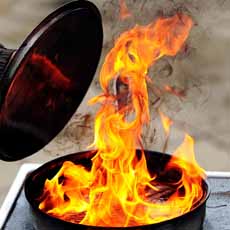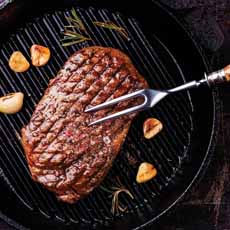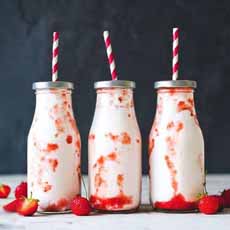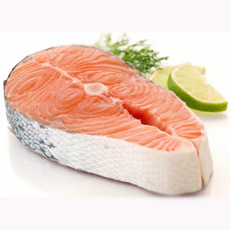|
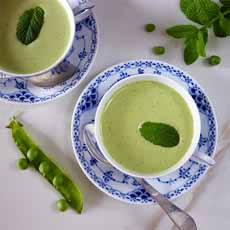
[1] Minted pea soup from John Woodhouse (recipe below; photos #1 and #2 courtesy John Woodhouse).
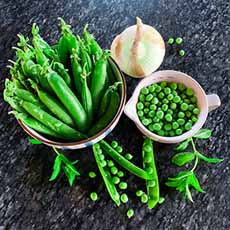
[2] Fresh spring peas give a flavor to the soup that frozen peas cannot.

[3] You can use half-and-half or heavy cream. See the footnote below (†) for the difference between half-and-half, light cream and heavy cream (photo courtesy Organic Valley).
|
|
While you can still find fresh spring peas in the produce department, here is a classic spring soup, beloved by everyone from Fanny Farmer to Julia Child…and modern chefs as well.
Elegant and a cheerful green color, it’s a world away from split pea soup, a rustic dish made from dried peas.
Spring pea soup is such a classic that you can find it on menus nationwide, as well as in the recipe collections on the Epicurious, Food & Wine, and Martha Stewart websites (and no doubt, hundreds and hundreds of others).
It can be served hot or chilled, in bowls, cups or for just a taste, in shot glasses. Its bright color brightens up the table.
PEA SOUP HISTORY
Pea soup dates to the cultivation of green peas in ancient Greece, as far back as 500 B.C.E. Sources show that street vendors in Athens sold hot pea soup (source).
The Mediterranean was not a dairying region, so creamy pea soup likely emerged in the northern climes of England and France.
This recipe, from chocolatier and home chef John Woodhouse of Woodhouse Chocolate in Napa Valley.
He’s been making the recipe for at least 20 years, in the style of rich soups from 19th century British and French cuisine. (Our Nana, who cooked the classic Continental repertoire, served her spring pea soup as as a first course before the spring leg of lamb* with mint jelly.)
RECIPE: MINTED PEA SOUP
This recipe tastes better when made a day in advance.
Ingredients
Ideally, make the soup the day before serving so the flavors can meld.
1 small onion, diced (about 1 cup, 4-1/2 ounces; you can substitute shallots)
2 tablespoons butter
1-1/2 cups shelled spring peas (a.k.a. English or garden peas; the smaller peas are sweeter)
1-1/2 cups chicken stock (preferably bone broth)
1 cup half and half (or heavy cream†)
1 tablespoon finely chopped fresh mint leaves
Salt and white pepper‡ to taste
Optional Garnishes
It’s easy to use one of the extra mint leaves as a garnish (as shown in photo #1). But people typically don’t eat the mint leaf, and we prefer the flavor contrast of chives. You can use one or all of the following:
Snipped chives
Dollop of crème fraîche (sour cream and Greek yogurt are heavy and tend to sink)
Swirl (or dots) of basil or rosemary olive oil
|
Preparation
1. SAUTÉ the onion in butter In a medium saucepan, until soft and translucent. Add the peas and the chicken stock. Bring to a boil, lower the heat to a simmer and cook until the peas are tender, about 5 minutes.
2. ADD the half and half and mint. Place the mixture in a blender and purée until smooth. Pour through a strainer, pressing any solids that remain to extract every bit of flavor.
3. SEASON with salt and pepper‡. Place the soup in a glass or plastic container (non-reactive) and chill at least 4 hours or overnight. If you have used heavy cream, your soup might need a little thinning to the desired consistency with some milk.
4. GARNISH as desired. Serve hot or chilled.
Variations
The original recipes used heavy cream, but many modern cooks, including John Anderson, lighten the recipe with half-and-half or even milk.
Other cooks have made additional substitutions and additions, including:
Sour cream or crème fraîche blended into the soup, in addition to the cream.
Varying blends of heavy cream, milk or buttermilk.
Vegetable stock instead of chicken stock.
Fresh parsley, tarragon and/or garlic in addition to the mint in the soup.
Some cooks add leeks in addition to the onions or shallots.
Some cooks use frozen peas—although they miss out on the magic of fresh pea flavor. This is a soup that should be made seasonally.
Some cooks add bacon or ham bones, as with split pea soup. However, we think this overpowers the fresh pea flavors.
________________
*In her day—and our childhood—before artificial insemination and imports from the Southern Hemisphere, fresh lamb was only available as nature birthed it, in the spring. Sheep naturally mate in the fall so that lambs are born in the spring, when the weather is mild and grass is plentiful.
†Half and half contains 10.5% to 18% butterfat (the average is 12%). Light cream and sour cream contain 18% to 30% butterfat (average 20%). Light whipping cream (often called simply “whipping cream”) contains 30% to 36% butterfat (average 35%). Heavy cream contains 36% to 38% butterfat. Here’s more about the butterfat content of different dairy products.
‡White pepper is used in fine cuisine to eliminate undesirable specks of black pepper in light dishes, such as mashed potatoes and white sauces. These days cuisine is less formal. Feel free to use the more flavorful black pepper. White pepper is black pepper with the outer skin removed. The skin and berry both contain piperine, the compound that creates the heat. When it is removed, there is less piperine and other flavor compounds, so white pepper is usually milder than black pepper, with less complex flavor.
|
